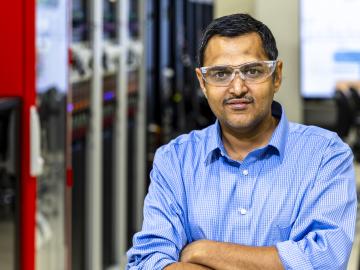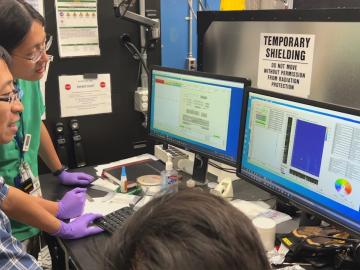
Filter News
Area of Research
News Type
News Topics
- (-) Advanced Reactors (6)
- (-) Artificial Intelligence (66)
- (-) Composites (13)
- (-) Grid (26)
- (-) Machine Learning (30)
- (-) Mercury (1)
- (-) Nuclear Energy (32)
- (-) Security (10)
- 3-D Printing/Advanced Manufacturing (40)
- Big Data (30)
- Bioenergy (26)
- Biology (40)
- Biomedical (18)
- Biotechnology (13)
- Buildings (30)
- Chemical Sciences (42)
- Clean Water (7)
- Computer Science (58)
- Coronavirus (3)
- Critical Materials (8)
- Cybersecurity (9)
- Education (5)
- Emergency (3)
- Energy Storage (24)
- Environment (61)
- Exascale Computing (39)
- Fossil Energy (5)
- Frontier (38)
- Fusion (20)
- High-Performance Computing (72)
- Hydropower (3)
- Isotopes (25)
- ITER (1)
- Materials (68)
- Materials Science (36)
- Mathematics (6)
- Microelectronics (4)
- Microscopy (10)
- Molten Salt (2)
- Nanotechnology (7)
- National Security (50)
- Neutron Science (47)
- Partnerships (53)
- Physics (23)
- Polymers (5)
- Quantum Computing (28)
- Quantum Science (29)
- Simulation (44)
- Software (1)
- Space Exploration (7)
- Statistics (3)
- Summit (22)
- Transportation (16)
Media Contacts

Sreenivasa Jaldanki, a researcher in the Grid Systems Modeling and Controls group at the Department of Energy’s Oak Ridge National Laboratory, was recently elevated to senior membership in the Institute of Electrical and Electronics Engineers, or IEEE.

ORNL has been selected to lead an Energy Earthshot Research Center, or EERC, focused on developing chemical processes that use sustainable methods instead of burning fossil fuels to radically reduce industrial greenhouse gas emissions to stem climate change and limit the crisis of a rapidly warming planet.

The Department of Energy’s Oak Ridge National Laboratory announced the establishment of the Center for AI Security Research, or CAISER, to address threats already present as governments and industries around the world adopt artificial intelligence and take advantage of the benefits it promises in data processing, operational efficiencies and decision-making.

ORNL hosted its annual Smoky Mountains Computational Sciences and Engineering Conference in person for the first time since the COVID-19 pandemic.

The Department of Energy’s Oak Ridge National Laboratory hosted its Smoky Mountains Computational Science and Engineering Conference for the first time in person since the COVID pandemic broke in 2020. The conference, which celebrated its 20th consecutive year, took place at the Crowne Plaza Hotel in downtown Knoxville, Tenn., in late August.

Carl Dukes’ career as an adept communicator got off to a slow start: He was about 5 years old when he spoke for the first time. “I’ve been making up for lost time ever since,” joked Dukes, a technical professional at the Department of Energy’s Oak Ridge National Laboratory.

In June, ORNL hit a milestone not seen in more than three decades: producing a production-quality amount of plutonium-238

The Exascale Small Modular Reactor effort, or ExaSMR, is a software stack developed over seven years under the Department of Energy’s Exascale Computing Project to produce the highest-resolution simulations of nuclear reactor systems to date. Now, ExaSMR has been nominated for a 2023 Gordon Bell Prize by the Association for Computing Machinery and is one of six finalists for the annual award, which honors outstanding achievements in high-performance computing from a variety of scientific domains.

Cadet Elyse Wages, a rising junior at the United States Air Force Academy, visited ORNL with one goal in mind: collect air.

Neutron experiments can take days to complete, requiring researchers to work long shifts to monitor progress and make necessary adjustments. But thanks to advances in artificial intelligence and machine learning, experiments can now be done remotely and in half the time.


